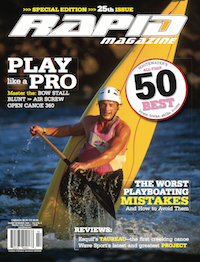Do paddlers have a death wish? Take a survey of non-paddlers on any city street and you’ll hear how paddlers are thrill-seekers who have a reckless need to be on—and often over— the edge. paddling may be more death-defying than golf, but a sociologist from the University of Calgary has just completed a research study which suggests that whitewater kayaking is less about cheating death and more about the controlled pursuit of a state of mind he calls “psychological flow.”
In his book Challenging Mountain Nature, Dr. Robert Stebbins takes an academic look at the motivation people have for pursuing leisure activities widely considered to be dangerous.
He interviewed kayakers, mountain climbers and snowboarders from Alberta’s Banff and Canmore areas about their level of commitment to their sports and how important their pursuits were to their lifestyles.
Stebbins argues that, instead of getting a buzz from flirting with death, kayakers are drawn to increasingly more difficult rapids to achieve a state of fulfillment called psychological flow, a stimulated state of mind enjoyed by people who have put themselves in situations that test their skills enough to inspire feelings that are in the healthy middle ground that exists between boredom and fear.
“We know we’ve achieved psychological flow when we don’t think of other things,” says Stebbins. “The feeling kayakers are after is one of being absorbed in the action of the moment.”
It is the rush of this state of absorption that drives kayakers to push their own limits to keep from being bored. According to Stebbins, this is a controlled progression and shouldn’t be seen as daredevil behaviour.
of course, there are exceptions. Unless you’re one of a handful of competent class V+ paddlers, dropping a 50-foot waterfall for the cameras would be paddling beyond your abilities—not an attempt to achieve psychological flow. Stebbins’ name for such Kodak courage is “social high risk behaviour,” and that, he says, is dangerous.



